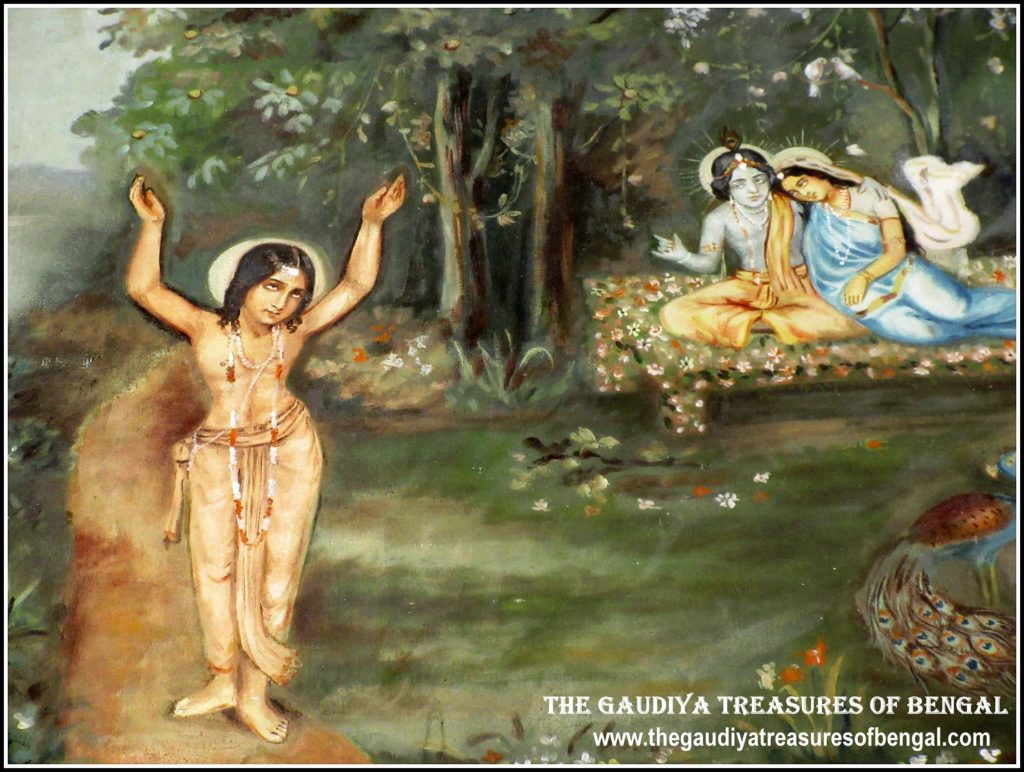
Hareh sakteh sarvam cid-acid-akhilam syat parinatir
Vivartam no satyam sruti mata viruddham kali malam
Harer bhedabhedau sruti vihita tattvam suvimalam
Tatah premnah siddhir bhavati nitya visaye
–
In their entirety, the material and spiritual worlds are the transformations of the energies of Sri Krishna, the Supreme Lord. Vivarta-vada, the impersonal theory of illusory transformation of Brahman, is false. It is venomous contamination in this age of Kali and is contradictory to the conclusions of the Vedas. The philosophy of Acintya Bhedabheda tattva (Achintya-Bheda-Abheda), the doctrine of inconceivable oneness and difference simultaneously, is the only true essence of the Vedas. The practice of this philosophy promotes a person to the perfectional stage of developing divine transcendental love for Sri Krishna, the absolute eternal Truth.
(Dasa Mula Tattva)
Philosophical understanding of the truth evolves and finally culminates into Acintya Bhedabheda Tattva (Achintya Bheda Abheda)
The teachings of the Upanishads are known as Vedanta. Srila Vyasdeva, desiring to articulate properly the meanings of Upanishads, summarized them systematically, resulting in a treatise with four chapters called the Brahma Sutra or the Vedanta Sutra. This summary of the teachings of the Vedas has always evoked spontaneous appreciation in scholarly circles. All the spiritual leaders from different philosophical schools have adopted ideas from the Vedanta Sutra to establish their individual judgments.
Sri Sankaracharya had attempted to establish Vivarta vada (Mayavada), the theory of illusory transformation of the Brahman, from the Vedanta Sutras. Mayavada is only one of the many theories proposing to define the reality of existence. Dissatisfied with this theory, Sri Madhvacharya formulated ‘dvaita vada’ or the theory of duality, where the Supreme Lord is deemed to be completely separate from His energies. After that came Ramanujacharya, who also after consulting the Vedas and the Vedanta-sutras, presented the philosophy of ‘visistadvaita vada’ or qualified non-dualism. Sri Nimbarkacharya studied the scriptures profoundly and formulated the theory of ‘dvaitadvaita vada’, the theory of simultaneous duality and non-duality. And then Vishnuswami, consulting the Vedanta sutras, formulated the theory of ‘shuddhadvaita vada’ or pure dualism.

The Mayavada doctrine (Vivarta vada) preached by Sri Sankaracharya is contrary to the basic principles of devotional science (bhakti). On the contrary, the four Vaishnava acharyas presented their various philosophies anchored to the truth of surrendering unto the Supreme Lord in devotion. Later Sri Chaitanya Mahaprabhu amalgamated the teachings of the four Vaishnava acharyas and extracted their essence to form the Acintya Bhedabheda tattva or the theory of inconceivable simultaneous oneness and difference between the Supreme Lord and His various energies. He consolidated the essence of the entire Vedic literatures in His philosophy.
What is Acintya Bhedabheda tattva (Achintya Bheda Abheda) ?
The Acintya Bhedabheda tattva propounds that the Supreme Lord and His energies are simultaneously one and different from each other. Analogies like sun and sunlight or gold and gold particles, which are simultaneously one and different from each other, help us better understand this theory. A drop of water obtained from the ocean is also salty. Likewise, the individual soul (jiva), which is part and parcel of the Supreme Lord, has all the qualities of the Supreme, but in minute quantities. The Supreme Lord is infinite while the living entities are infinitesimal. The individual souls are subordinate and dependent upon the Supreme Lord eternally.

Both ‘Bheda’ (difference) and ‘Abheda’ (oneness) exist simultaneously between the Supreme Lord and individual beings, but how these two are reconciled, cannot be understood by mere logic. The simultaneous oneness and difference between Shakti (energy) and Shaktiman (energetic) cannot be grasped through intellectual reasoning. Therefore, it is called ‘Acintya’ or inconceivable. As the powers of the Supreme Lord are inconceivable and cannot be perceived through logic and speculation, the Vedic scriptures advise us as follows:
Naisa tarkena matir apaneya
(Katha Upanishad, 1.2.9)
–
O Nachiketa! Now that you have attained the transcendental consciousness of Self-knowledge, do not squander it through dry empirical discussions.
Elsewhere, the Mahabharata states :
Puranam manavo dharma
Sango vedas chikitsitam
Ajna siddhani catvari
Na hantavyani hetubhih
–
The sattvika Vaishnava Puranas, the religious laws of Manu, the six schools of Vedic philosophy, the entire literature and medical science of the Vedas, are the four perfected subjects directly spoken by the Supreme Lord. No one must challenge or debate upon these subjects, in an attempt to misrepresent their clear and primary purport.
Scriptural References that uphold Acintya Bhedabheda tattva (Achintya Bheda Abheda)
The rich and the fathomless treasure of Vedic literatures contain countless verses supporting the ‘bheda’ (difference) and ‘abheda’ (oneness) principle concerning the Supreme Lord and His energies. Every portion of the Vedas is completely perfect and no part can be dismissed as trivial. The eternal ‘oneness’ is as much a timeless and eternal principle as the inherent ‘duality’. In this way, the principle of Acintya Bhedabheda is upheld in the scriptures – even though this principle of simultaneous oneness and difference is materially inconceivable and therefore outside the scope of Man’s mental ability. Some of these verses are presented below.
Verses that imply the oneness (abheda) of Supreme Lord and the living entities (jiva)
#1
Sarvam khalv idam brahma
(Chandogya Upanishad, 3.14.1)
–
Everything, both matter, and spirit are non-different from the Supreme Personality of Godhead who is the Supreme Brahman.
#2
Atmaivedam sarvam iti
(Chandogya Upanishad, 7.25.2)
–
This entire cosmic phenomenon is atma, the Supreme soul
#3
Sad eva saumyedam agra asid ekam evadvitiyam
(Chandogya Upanishad, 6.2.1)
–
Uddalaka said to his son Svetaketu, “Before this phenomenal universe came into being, only the one non-dual eternal being was present”.
Verses that imply the difference (bheda) between Supreme Lord and the living entities (jiva)
#1
nityo nityanam cetanas cetananam eko bahunam yo vidadhati kaman
(Katha upanishad, 2.2.13)
–
The Supreme Lord (Bhagawan) is the Supreme eternal amongst all other eternal beings. He is the fundamental conscious being among all the other conscious beings. The difference lies in the fact that the Supreme Lord is supplying the necessities of life for all the other living entities.
#2
dva suparna sayuja sakhayah samanam vriksham parishasvajate tayor anyah pippalam svadv atty anasnann anyo ‘bhicakasiti
(Mukunda Upanishad, 3.1.1)
–
The Lord and the living entity are compared to two birds sitting in the same tree. While the illusioned living entity eats the fruits of the material world, the Lord as Supersoul and best friend witnesses these actions.
#3
satyam jnanam anantam brahma
Yo veda nihitam guhayam parame vyoman
So snute sarvan kaman saha brahmana vipasciteti
(Taittiriya Upanishad, 2.1.2)
–
The supreme absolute Brahman is the embodiment of eternity, spirituality and He is transcendental to the purview of material time, place, and senses. One who has realized this truth that the Supreme Brahman is simultaneously situated in the spiritual sky and also in the heart of the jiva is sublimely attached with the Supersoul in a loving relationship that fulfills all his spiritual desires.
#4
Yathatathyato rhan vyadadhac chasvatibhyah samabhyah
(Isopanisad 8)
–
He has fulfilled the desires of everybody since time immemorial by dint of His acintya sakti (inconceivable power).
#5
Yasmat param naparam asti kinchid
Yasman naniyo na jyayo sti kinchit
Vriksha iva stabdho divi tisthaty ekas
Tenedam purnam purusena sarvam
(Svetasvatara Upanishad, 3.9)
–
There is no one superior to Him (Supreme Lord). He is smaller than the smallest and greater than the greatest. He always stays fixed in His situation like a tall towering tree. He is always present in the resplendent abode of transcendence, and simultaneously He resides in the inner Sanctorum of the universe, as the Paramatma (Supersoul), by dint of His inconceivable prowess.